Are mushrooms healthy? Like the kinds that you can find at the grocery store? The overwhelming answer is: yes, they are a ‘superfood’. Mushrooms are healthy and have many nutritional properties that make them an important part of a balanced diet. They help the human immune system to function properly in addition to being a high nutrient value, low calorie sustenance. Mushrooms augment gut health and immune regulation.
Here are some nutrients of mushrooms: Amino acids, B vitamins, trace minerals, and Psilocybin is also being studied for its therapeutic benefits to mental health, which is the psychotropic compound found in “magic mushrooms”. The ‘stoned ape theory’ (Terrence McKenna) states that mushrooms were a primary factor enabled the immense increase in brain power of the human species that separates humanity from other animal species and perhaps gave birth to language as we know it. This theory hasn’t received a lot of attention from the scientific community due to McKenna’s lack of anthropological data and evidence. However, Paul Stamets began to introduce his research on Mycology, which has reinvigorated the subject of debate and helped to bring new understanding the how mushrooms function in nature.
Mushrooms are “packed with vitamins, minerals and other nutrients.1” There are over 10,000 types of fungi that produce mushrooms, which are actually the fleshy fruiting body of a fungus; hyphae is the term used for the roots.
There are also species of mushrooms that are decidedly unhealthy; even some that are deadly. Don’t eat a mushroom, or anything for that matter, unless you can properly identify it.
Mushrooms are incredible lifeforms; some scientists believe they were some of the first organic life forms on planet Earth. The roots of mushrooms, called Mycelium is a network of hyphae, which can develop from a single spore, produced by the fungus3. Mycorrhiza is the mutual association between the fungus and the plant, which play important roles in plant nutrition, soil biology, and soil chemistry.
The Anatomy of a Mushroom

Mushrooms have common features, though there are several deviations that are very interesting. Here are the major features:
- Caps – can be scaled, warted, or have areolae, some are moist
- Margin, containing gills, spines, teeth or pores under the cap
- Spores are released from under the cap
- Ring, skirt, or annulus, remnants of reproduction
- Stipe or stalk
- Volva or cup
- Basal bulb – connects the mushrooms to mycelium
The Stages of Growth of a Mushroom
The life cycle of a mushroom can be a couple days to several years, to hundreds or thousands of years. There are several distinct stages to the growth.
- Spores drop from mushroom cap, spores are the seeds of a mushroom
- Two spores fuse and become a hyphae, long tubular structures with genetics
- Hyphae link to Mycelium, to obtain nutrients from mycelium to the fruiting body of the mushroom.
- Baby mushrooms are formed in a hyphal knot, pinheads begin to grow out of the Mycelium
- Growth and maturity
Mushroom Function in Nature
![Catherine N. Jacott, Jeremy D. Murray and Christopher J. Ridout - [1] doi:10.3390/agronomy7040075](https://elliottelford.com/wp-content/uploads/2022/03/arbuscule.png)
Mushrooms are the fruiting body of the mycelium and arbuscules are the site of nutrients exchange between a plant and the fungi. Mushrooms, Mycelia and Mycorrhizae are very important for plant and tree root systems to absorb nutrients surrounding the roots and to create resilience against drought, salt, heavy metals, and pathogens.
Most mushrooms are anti-viral and anti-bacterial, and also fight cancer and aging in various ways by boosting the immune system in humans. In short, they are very good for overall health, in ways that science doesn’t fully understand yet. Many pharmaceutical drugs are made using chemicals and molecules derived from mushrooms. Compounds successfully developed into drugs or under research include antibiotics, anti-cancer drugs, cholesterol and ergosterol synthesis inhibitors, psychotropic drugs, immunosuppressants and fungicides.
Mushrooms as organisms are very unique. Mushrooms with psychoactive properties have long played a role in various native medicine traditions in cultures all around the world. They are rich in vitamins and will absorb the metals surrounding them, as proven by their ability to absorb Cesium after Chernobyl.
They can be bad for the body in ways that the general population doesn’t know yet either. Some mushrooms can cause liver and circulatory toxicity when taken in high amounts over long periods of time. Some cause death when eaten. Some are just dangerously poisonous. There is a lot of research to be done to fully understand how these complex organisms interact with the human body.
The benefits of the mushroom are noted largely by their species; each has different nutritional properties and interacts with the human body uniquely, just as each species of mushroom functions differently in nature. Each will have a different reaction within the body due to the diversity of human microbiomes; cooking is used to reduce toxic chemicals.
Some general characteristics and benefits of mushrooms species are noted below. Please do some of your own research and comment on what you find!
Mushroom Nutrition
Basically, mushrooms are good for the human immune system. They contain polysaccharides, amino acids, minerals, anti-oxidants, and are anti-inflammatory. Various compounds from mushrooms are being studied for their positive effects on heart health, blood sugar levels, digestion, immunity, and cellular regeneration; many compounds are being researched for their ability to fight cancer. In short, mushrooms are certainly part of a healthy diet and are a low calorie alternative to processed foods. In fact, many mushroom species are resilient to commercialism, and are extremely difficult if not downright impossible to cultivate.
Mushrooms Species
Oyster Mushrooms

These mushrooms are a common edible. They are carnivorous (they eat nematodes and also diesel fuel) and are often used in oyster sauce and various kinds of soup, especially in Asia. It can be found in subtropic and temperate forests. These mushrooms boast high nutrient values (because of their carnivorous nature), high anti-oxidant content, helps to lower blood pressure, blood sugar, cholesterol, and insulin levels. It can also help to improve respiratory tract infections, especially in HIV positive patients. There is also a significant potential for anti-carcinogenic properties and gut health/anti-inflammatory effects. They are also delicious when cooked. More research is needed to understand exactly how the mushrooms interact with the gut and human microbiome, but the general consensus of the scientific community is pretty unanimous to these being a great addition to a healthy diet.
Bolete Mushrooms

Also known as a porcini or porcino mushroom, these are found all over the world, but was only recently introduced to the Southern Hemisphere. These are difficult mushrooms to commercialize and are mostly foraged. The mushrooms spans root systems and fruit during summer and autumn. It is prized as a culinary edible and is highly regarded for its taste in risotto, pasta, and soup, though it is very difficult to cultivate. It is one of the few mushrooms known for being delicious when pickled. They vary in size. These mushrooms have a tremendous amount of amino acids; more than any other Portuguese mushroom. They contain lots of fatty acids: palmitic acid, stearic acid, oleic acid, and linoleic acid. They are also rich in dietary minerals: sodium, iron, calcium, magnesium, b vitamins, and tocopherols, as well as trace amounts of bioavailable selenium. It also contains a diverse host of phytochemicals: ergosterol and ergothioneine and polyphenols: rosmarinic acid, oxalic acid, citric acid, succinic, and fumaric acids and alkaloids. Suffice to say that this mushrooms species can have tremendous nutrient diversity; if soil composition is diverse enough to support it.
White Button Mushrooms
These are less-mature cremini mushrooms. See below.
Cremini Mushrooms
Cremini or Crimini mushrooms are from the species Agaricus bisporus which includes portobello mushrooms and white button mushrooms. These are all the same type of mushroom, but portobello are the most aged and white buttons the youngest. Age gives them different and more pronounced flavors.

These are the classic mushrooms for fine dining and cuisine and have numerous health benefits, including being anti-inflammatory and reducing blood pressure and alleviating hypertension, which seems to be a characteristic of edible mushrooms. There are B vitamins, D vitamins, Zinc, Iron, Copper, anti-oxidants and some fiber and protein. In short, they are good for balancing gut health; especially when cooked, there are very few side effects.
The presence of selenium in mushrooms is also a huge contributing factor to their health benefits. Selenium is nutritionally essential for humans and is a constituent of more than two dozen selenoproteins that play critical roles in reproduction, thyroid hormone metabolism, DNA synthesis, and protection from oxidative damage and infection. Its important.
Agaritine, which is a carcinogen is present in these mushrooms so eating large amounts of them can imbalance the gut in a big way; but the toxins are degraded when cooked. Plus its only present in small amounts so you would have to eat a large amount of moldy mushrooms in order for it to affect you.
Cordyceps Mushrooms

There are over 600 species of cordyceps mushrooms, mostly in tropical and humid areas in Asia and is a mostly parasitic species of mushrooms, feeding on other mushrooms and insects. The fungus takes over the bodies and brains of its victims forcing their zombified bodies to permanently relocate to the trees and low-lying jungle plants where the conditions are ideal for the fungus to thrive. They are used in traditional medicine across the spectrum of asian religious practices specifically Ayurveda and traditional Chinese medicine, as well as spiritual mushrooms practices.
Table of Cordyceps benefits from the national library of medicine (https://www.ncbi.nlm.nih.gov)
Traditional uses of Cordyceps sinensis (Yercha gumpa) in North Sikkim

Cordyceps is a very interesting mushrooms that we simply do not know a ton about yet. It has been proven to increase stamina and blood oxygen regulation in mice, but beyond that, we don’t have a lot of evidence of how it creates these benefits within the body. However, we do know that it is anti-parasitic.
Turkey Tail Mushrooms – (Trametes versicolor)

This is a common mushroom with a variety of benefits. Paul Stammets sells this mushroom supplement on host defense, due to its benefits for gut health, anti-inflammatory properties, and ability to slow and stop the spread of cancer by enhancing natural killer cell activity in the host body. His mom, after being diagnosed with breast cancer and three months to live went on to live an additional ten years eating eight turkey tail capsules a day. One chemical in the mushrooms, polysaccharide K, is being studied in Japan for its anti-carcinogenic qualities.
Shiitake Mushrooms
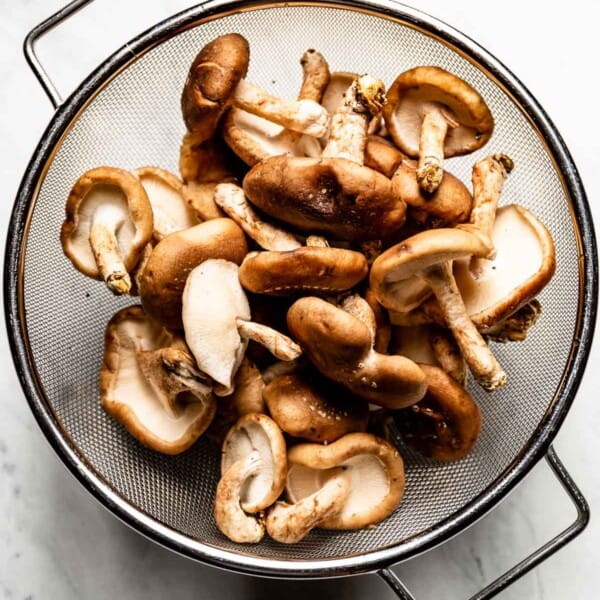
Originating in East Asia, Shiitake mushrooms are now cultivated all over the world for their taste and are used in traditional medicine. They grow on the decaying wood of deciduous trees, particularly shii and other chinquapins, chestnut, oak, maple, beech, sweetgum, poplar, hornbeam, ironwood, and mulberry. These are more of a culinary mushroom rather than medicinal, however, shiitake mushrooms still are a low carb, low calorie food that increases immunity. It has been known to cause allergic dermatitis reactions, but these are sometimes mitigated by cooking the mushrooms. Shiitake mushrooms account for about 25% of all commercially cultivated mushrooms.
King Trumpet Mushrooms

King Trumpet Mushrooms are a off-shoot of the oyster mushrooms genus, and are very similar in their benefits. They have tons of fiber, support bone health, and boost the immune system and energy levels of the host. It also has been shown to lower cholesterol. These mushrooms are believed to have co-evolved with nematodes which they can consume predatorily.
Chanterelle Mushrooms

Chanterelles are some of the most popular wild mushrooms to forage. These mushrooms contain mostly water, but also B vitamins, a little protein and fiber and carbohydrates. They are rich in iron, D2 (from sunlight exposure), and riboflavin, magnese, and potassium.
Porcino Mushrooms
See Boletus Mushrooms, same species.
Enoki Mushrooms

This mushroom is mostly known for its use in Japanese cuisine, Flammulina filiformis. It originated in China, but grows naturally in Japan, and Korea as well and is used commonly in asian cuisine for soups. Like other mushrooms, it grows on deadwood and is cultivated sometimes with sawdust.
One hundred grams of dry enoki mushrooms provide 346 calories, of which 53% is carbohydrates, 26% is protein, 26% is dietary fiber, and 3% is fat. Vitamins and minerals found in enoki include niacin, calcium, iron, potassium, and riboflavin.
In Asian medicine, enoki mushrooms have been used for centuries to treat high blood pressure, high cholesterol, liver disease, and stomach ailments.
There are tons of amino acids in Enoki mushrooms, and also lots of trace minerals and some electrolytes and even iron. And the high water content is probably what makes it so beneficial for the stomach and liver.
Hedgehog Mushrooms (Hydnum repandum)

Also known as sweet tooth or wood hedgehog, these mushrooms are mostly identified by the spines that descend from the roof rap instead of gills. The capo is yellow or light orange and the stem is white, mostly with irregular shaping of the caps and spicy/bitter taste. It also has no poisonous look-alike, which is a major concern for some of the mushrooms that are foraged. It is broadly distributed in European woodlands and fruits during summer and autumn.
It has a nutty taste and crunchy texture, and is well recognized for its edibility. Some even say that it is similar to oysters.
The mushroom is full of nutrients, and seems to be extremely adept at absorbing heavy metals including Cesium from the Chernobyl disaster. It is especially high in copper and manganese, and fatty amino acids.
Armillaria (Honey Fungus Mushrooms)
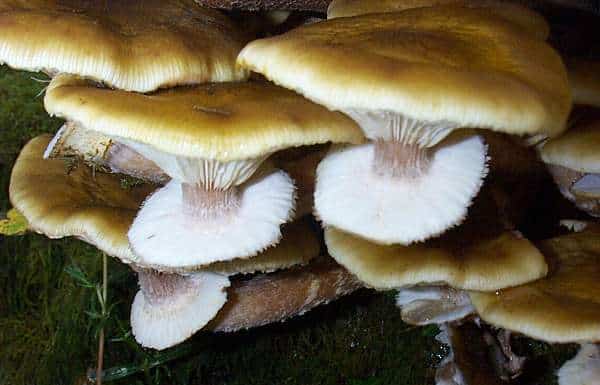
These mushrooms form the largest living and oldest organisms in the world. In Oregon’s Malheur natural forest, one is know to cover 3.5 square miles and is over 2,500 years old. They are often bioluminescent. Armillaria can be extremely destructive to forests; it causes white rot root disease in trees. It is known to consume decaying and dead plant matter, making is parasitic. The only trees known to be resilient are birch and larch.
Their caps are yellow and brown, somewhat sticky or moist, and has at least one look-alike that is deadly poisonous called Galerina. It usually fruits during autumn.
Honey fungus is regarded as one of the best wild mushrooms in many places in Europe, but they must be cooked because they are slightly poisonous raw. They are more poisonous when ingested with alcohol. They are described as being slightly sweet when cooked.
Several antibiotics have been created from Armillaria14. They are prescribed in China for treating a variety of neurological conditions including Meniere’s Syndrome, vertigo, headache, insomnia, epilepsy, neurasthenia and hypertension. It has high levels of polysaccharides and several indole compounds have been isolated from it, including serotonin. It is also shown to be anti-glycemic, an anti-oxidant, seems to enhance brain function, and has powerful immune boosting activities that promote killer T cells, which balance the bodies bacteria and help to prevent illness. Overall, this mushroom is extremely beneficial, but must be cooked and ingested with care, as it is slightly poisonous raw.
Shimeji Mushrooms

This mushroom is native to East Asia but it cultivated in North America and Europe. It should always be cooked and is normally used in soups and stews and stir-fry. It is rich in Guanylic acid, Glutamic acid, and aspartic acid all of which are amino acids.
It is high in B vitamins, potassium, phosphorus, fiber and iron. It is also a source of selenium, which is good for skin health. It also is high in copper, which is good for heart health, immunity, and gut balance. It is also well known for its cancer fighting abilities.
Morcella or Morel Mushrooms
These mushrooms are highly prized because they only grow in the wild in North America and Europe and are very difficult to cultivate. Typical fruiting season is spring. They seem to do well in alkalized soils, especially after medium intensity wildfires though they are notoriously difficult to find. They are slightly poisonous so they must be cooked and shouldn’t be eaten in massive quantities or with alcohol.
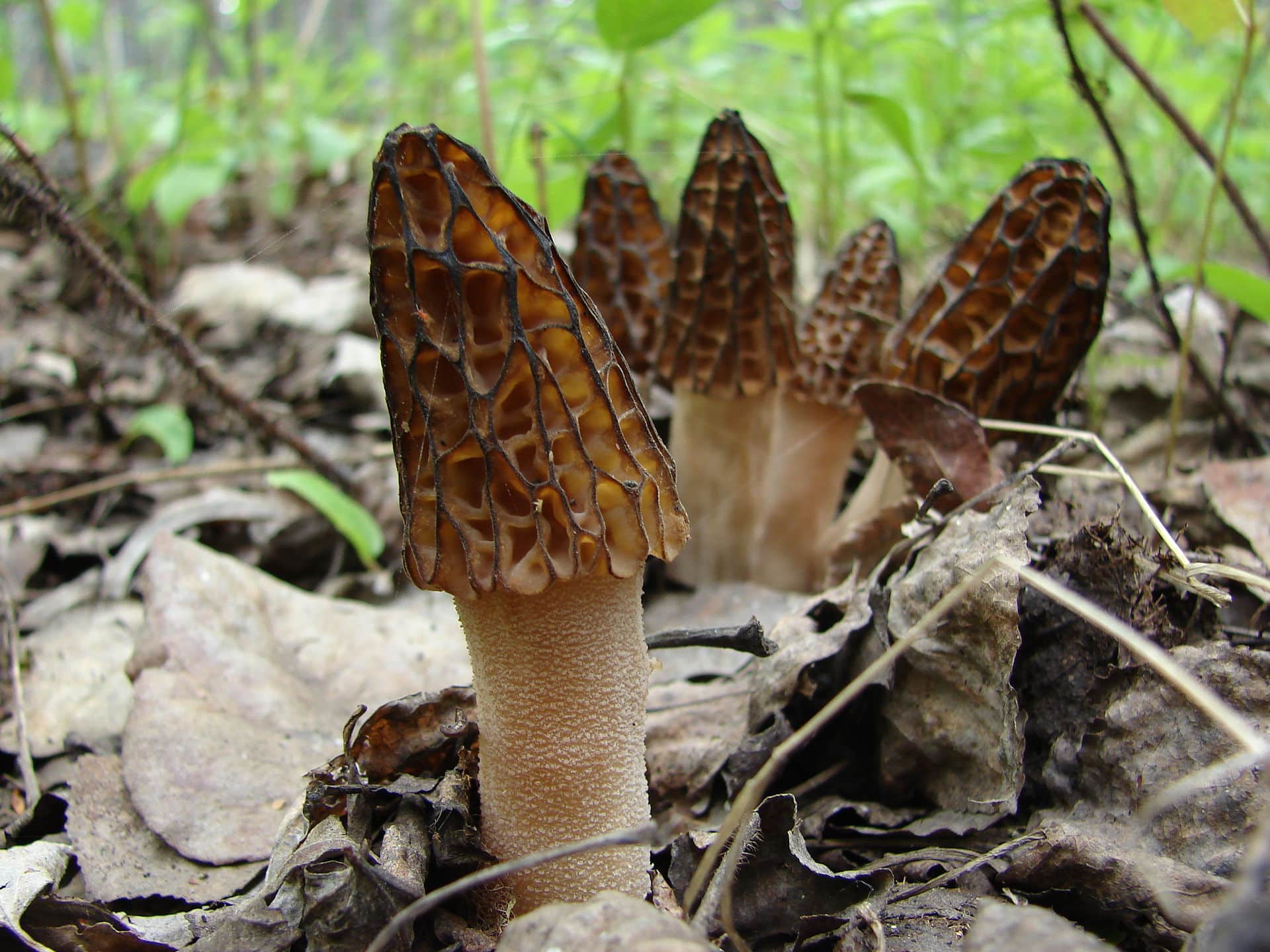
There are 80 different species of Morel mushroom and most are found under trees. Raw morel mushrooms are 90% water, 5% carbohydrates, 3% protein, and 1% fat. A 100 gram reference amount supplies 31 calories, and is a rich source of iron (94% of the Daily Value, DV), manganese, phosphorus, zinc, and vitamin D (34% DV, if having been exposed to sunlight or artificial ultraviolet light).
Matsutake Mushrooms
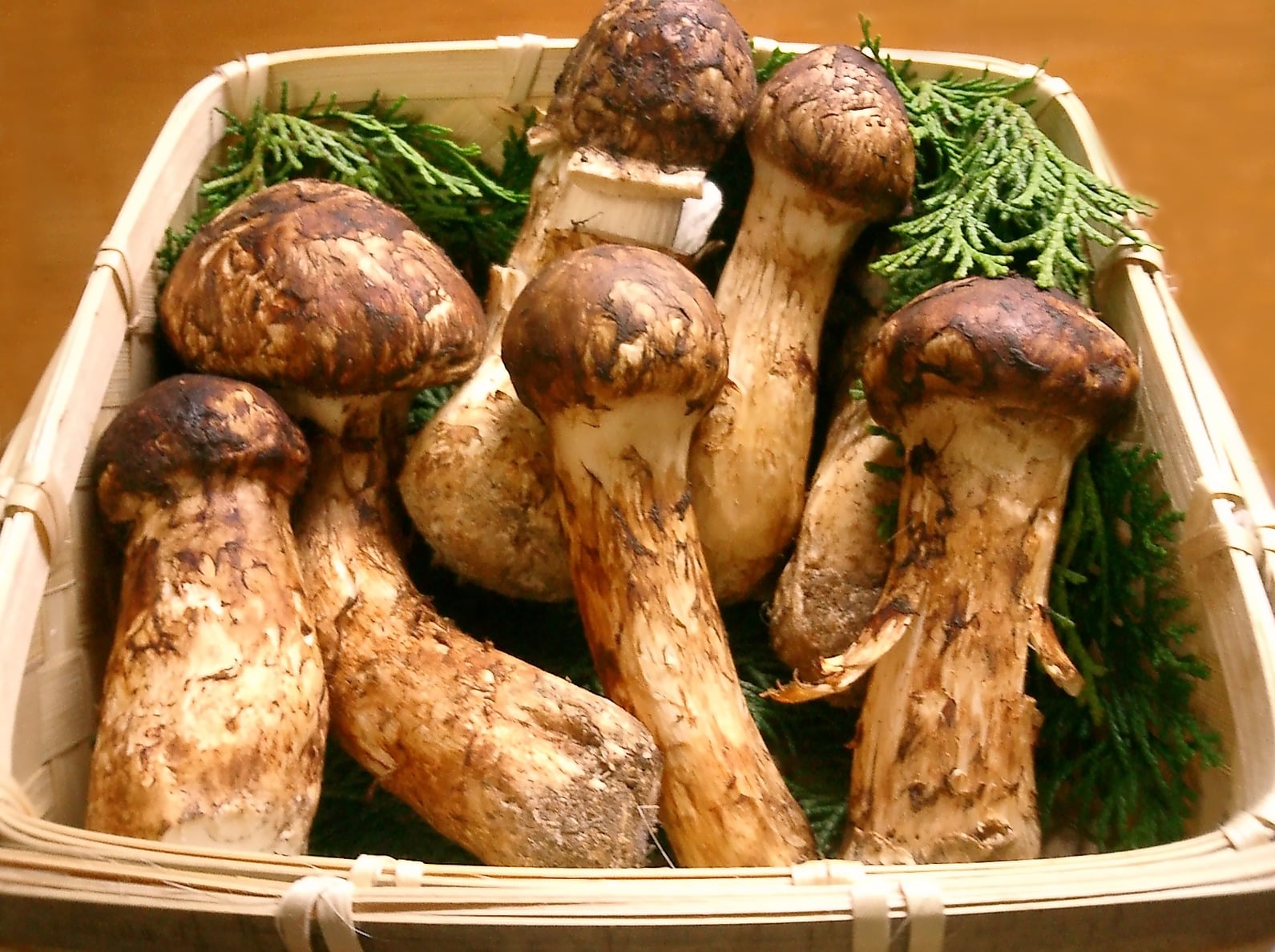
These edible mushrooms are found throughout East Asia, Europe, and North America and are enjoyed for their aroma as well as their taste. They are becoming rarer, as competition is fierce for their once a year harvest. They are very difficult to cultivate. It is listed as “vulnerable” due to habitat destruction. Similar to other mushrooms, it has high vitamin content, as well as amino acids, fiber, and is anti-bacterial and anti-fungal. It shares most of the characteristics of the other mushrooms, but perhaps with more protein, and more fiber than most other species.
Maitake Mushrooms – Hen of the Woods, King Mushroom (Grifola frondosa)

This mushrooms has considerable health benefits, and grows wild under elm, oak, and maple trees. It has been shown to stimulate the immune system and can also beneficial for people who have been diagnosed with diabetes.
Benefits: Adaptogenic, antioxidant, useful in preventing and treating breast cancer2, suppresses tumor growth2
Maitake Mushrooms are rich in the following nutritional properties:
- beta-glucans
- vitamins B, C, and D
- copper
- potassium
- fiber
- minerals
- amino acids
Lion’s Mane Mushrooms (Hericium erinaceus)
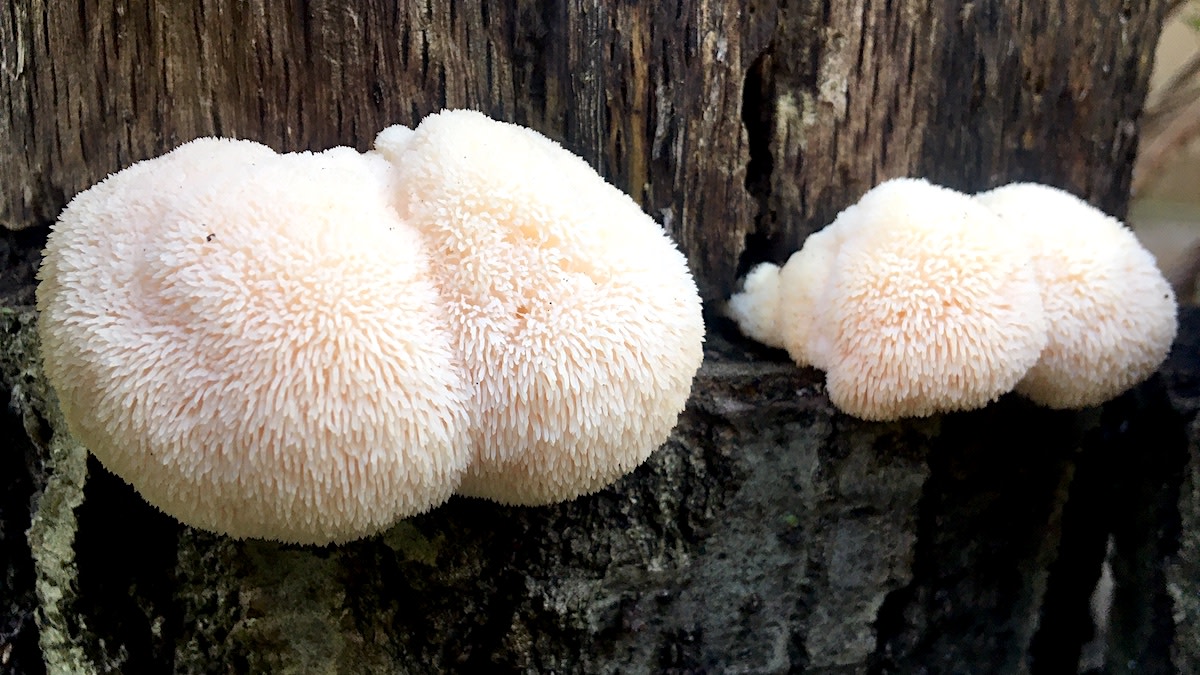
Lion’s mane mushrooms are brain boosters and are implicated in neurogenesis and are getting a lot of attention in reducing Alzheimers and Parkinson’s disease and has been used in traditional Chinese medicine. They are being investigated by pharmaceutical companies for Erinancine, which enhances nerve growth amongst other cognitive benefits7. It may help the nervous system to repair itself faster. They typically grow on dead American Beech trees.
Reishi Mushrooms

Reishi mushrooms contain adaptogens and help the body to combat stress. They are known as the king of mushrooms because of their origins in East Asia and use in traditional medicine. They are immune boosters by improving lymphocyte function and increasing white blood cells counts in a very similar way to most mushrooms, but specifically have high amino acid content, which can help fight infection and cancer. This may occur primarily in those who are ill, as mixed results have been seen in those who are healthy8.
Chaga Mushrooms

These mushrooms typically grow on birch trees and resembled a dark chunk of dirt; scientists are getting increasingly interested in the health benefits because of its ability to fight and prevent cancer through triterpenes, which cause cancer cells to self-destruct without affecting healthy cells4. It is also rich in antioxidants and lowers cholesterol, which can help to prevent heart disease. It is also anti-inflammatory by regulating cytokine production, which can help to combat arthritis.
Here are some nutritional properties of Chaga mushrooms:
- B-complex vitamins
- rubidium
- cesium
- amino acids
- fiber
- zinc
- iron
- manganese
Healing Mushrooms, “Magic” and Psilocybin
Mushrooms are increasingly studied around the world for their pharmacological health benefits. Lion’s mane is implicated in faster nervous system regeneration after a stroke.
There are 4 different substances that create the hallucinations: psilocybin, psilocin, baeocystin and norbaeocystin. There isn’t a lot known about the substances, however they are psychotropic alkaline analogues to psilocybin, meaning they alter the way the psilocybin is processed to create hallucinatory effects in the brain. Not a lot of data is available due to hallucinogenic mushrooms being illegal in most countries.
Psilocybin and the other hallucinogenic compounds are known to interact with Serotonin and the HTP Axis or stress response. This is the most likely explanation for mushrooms being seen as a cure for depression.
We will wait to discover and understand what the real healing capacity of Psilocybin and the other hallucinogenic compounds can be.
Please leave a comment or share this article if you found it to be useful. I tried to combine as many high quality sources and do as much research as I could.
References
- Time Magazine – Are Mushrooms Healthy
- Healthline
- Micropia
- Real Eats
- Medical News Today
- Rejuvii
- Erinacine Wikipedia Page
- 6 Benefits of Reishi Mushrooms
- Draxe.com Cremini Mushrooms – Cremini Mushrooms Benefit the Heart, Gut & Fight Against Cancer
- NIH on Selenium
- Bolete Mushrooms
- Health Benefits of Enoki Mushrooms
- The Life Cycle of a Mushroom
- Honey Mushroom Nutrition
- Shimeji Mushroom Nutrition
- Mushrooms Analysis

